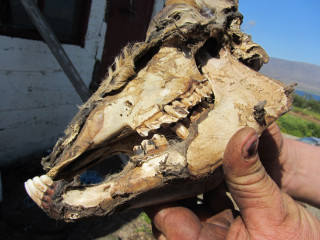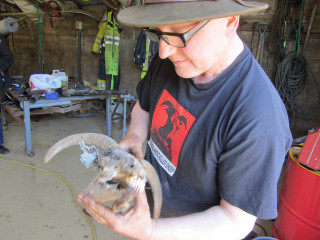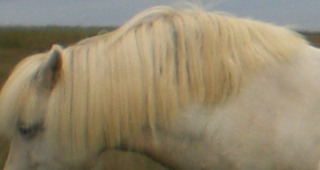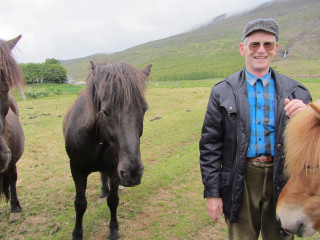In October last year, high levels of fluoride were discovered in hay grown on three farms around Alcoa’s Fjarðaál aluminium smelter in East Iceland. In response, the company announced that their much-acclaimed pollution control technology had failed at some point in the summer and claimed that they had “acted immediately” to deal with the situation. In mid January the results of tests on hay which Alcoa itself had submitted to the Food and Veterinarian Authority (MAST) came back, showing that fluoride levels were “below the maximum limit” – 50 mg/kg for cows, goats and sheep, but 30 mg/kg for dairy cattle – and therefore safe for livestock. Two out of seventeen samples were, in fact, above the acceptable fluorine limit for milking cows for human consumption but this was deemed to be fine since that farm only had horses.
The truth is that aluminium smelters and serious fluoride poisoning go hand in hand. Aluminium smelting is the largest single producer of fluorides worldwide. These toxic compounds are released from smelters in both gaseous and solid forms. ‘Scrubbers’ are usually used to remove the majority of fluorides from factory smoke today, but when those scrubbers are spent they are also dumped in landfills where the soluble fluorides absorbed into them can leak out into the soil. Fluorides are phytotoxic (toxic to plants) and actually accumulate in vegetation, making long living trees particularly susceptible to fluoride poisoning. When animals or humans eat fluoride polluted plants or meat, or drink fluoride rich water, they can develop ‘fluorosis’ which weakens bones and teeth and can, in extreme cases, lead to bone deformation and birth defects. Fluoride can also build up in soft tissue in the body causing a range of serious health effects1.
Swollen Jaws and Weak Teeth
In West Iceland, a number of farmers living around the Century Aluminum (Norðurál) smelter in Hvalfjörður have been suffering serious fluoride pollution in their sheep and horses – in particular since a major pollution incident at the factory released large amounts of fluorides in August 2006.
Sigurbjörn Hjaltason and his wife Bergþóra run a sheep farm at Kiðafell on the South side of the fjord, across the water from the 280 thousand ton aluminium smelter and Elkem’s steel alloy factory. Their sheep have recently developed swollen jaws and weak teeth which break easily and are, in some cases, unable to feed properly and have therefore died. Not satisfied with the industry’s own monitoring, they sent a few of their sheep heads for independent investigation and found fluoride levels of up to 1300-1400ppm, against a baseline (normal level) of 300-400ppm. Sigurbjörn and Bergþóra point out that Umhverfisstofnun (The Environment Agency of Iceland) give no maximum level of fluoride permitted in livestock teeth in Century Aluminum’s license, or elsewhere. Norðurál themselves use a guideline that is based on Norwegian research on young deer and suggests that between 1000 and 2000ppm can cause damage to teeth, and above 2000ppm damage is certain to occur. Sigurbjörn and Bergþóra claim that even this guideline is too high to prevent disease and even death of sheep as they have experienced.
Despite complaints regarding the unacceptably high levels for permitted fluoride, filed by Sigurbjörn and Bergþóra to Umhverfisstofnun and MAST (Iceland’s Food and Vetinary Authority), the situation has not improved.
A Story of Silence
Across the fjord, about four kilometers West of the smelter, stands a farm called Kúludalsá. The owner, Ragnheiður Þorgrímsdóttir, runs an outdoor education center and keeps horses for pupils to ride and learn from. She has looked after horses since her childhood without problems, but in 2007 her horses suddenly started to get sick. They developed a build up of material in the neck and became stiff and unwell, in some cases too stiff to be able to walk. In an interview with Saving Iceland, she explained that in August 2006, while Century were expanding their smelter, a failure occurred in the plant’s scrubbing system with the results that raw fluoride was emitted for at least 20 hours. Local farmers were given no warnings or information, “They told no-one about it until many months later when they were forced to do so because the figures showed that something serious had happened” Ragnheiður said.
She wrote to MAST and requested a formal investigation in April 2009. The agency passed her request to Umhverfisstofnun who declined to act on it until two years later under public pressure. Ragnheiður had already sent samples of bones to local labs, discovering fluorine levels about four times higher than the estimated baseline, nevertheless still technically below the legal limit. In May 2011, she told her story on RÚV, Iceland’s National Broadcasting Service; only two days later she received a letter from Umhverfisstofnun, announcing their formal refusal to investigate the matter.
Finally in spring 2011, MAST agreed to investigate samples of horse teeth and bones from Kúludalsá. However, they didn’t examine fluoride in the liver and other organs as they had been requested to do, claiming that fluoride doesn’t build up in the soft tissues. Following their investigation MAST terminated her case, concluding that Ragnheiður could be blamed for the horses’ sickness herself which was due to overfeeding. At this point she decided to take matters into her own hands and sent samples to a foreign laboratory for further analysis. The lab found high fluoride levels in the liver, spleen, kidney and muscles, proving that fluoride had indeed been accumulating in the soft tissue of the animals – and suggesting that this may be an ongoing issue.
She wrote to the Minister of Environment in spring 2012, and later also to the Minister of Industry and Innovation. Finally in autumn 2012 she was able to meet with both of them and explain her situation in detail. She told Saving Iceland that the two ministers listened to her and resolved to further investigate the matter. They have now appointed two experts to look into the matter in more depth.
In an article on her website (Námshestar), published last autumn, Ragnheiður tells her story in detail through the whole period of her dealings with the authorities, from the moment she first noticed the horses’ illness up until the day of the article’s publication. Her conclusion is the following:
I have fought for in-depth research of the horses and their environment for a few years. Eventually, I was forced to do it myself. After the findings of tests on several biological specimens (monitoring that neither Iceland’s Environment Agency nor MAST were willing to conduct) I believe there to be a well-grounded suspicion that the horses are suffering from a metabolic disease (equine metabolic syndrome) as a result of too much fluoride in grass and hay. In addition to causing calcium deficiency in blood and damaging both teeth and bones, fluoride also impacts the activity of the thyroid which operates the body’s metabolism. Fluoride also wears away magnesium and other important substances.
Regarding her dealings with the authorities, she concludes by stating that her experience through the last years has taught her “not to expect important affairs to receive speedy and conscionable process within public administration in Iceland.” In particular she points out how the local authorities have actively ignored repeated warnings about pollution from the Grundartangi industrial complex and appear to be working for the interests of the industry rather than the people. This fits in with the Icelandic government’s original invitation to energy intensive heavy industry in 1995, which was entitled ‘Lowest Energy Prices!’ and promised ‘a minimum of red tape’ on environmental clearance for foreign industrial companies setting up in Iceland.
More Industry: More Pollution: Less Democracy
Century Aluminum (Norðurál) are supposed to measure fluoride levels around their Grundartangi plant, but according to local nature-protection organization, Umhverfisvaktin við Hvalfjörð (Hvalfjörður Environment Watch), the company stops monitoring the wider local area during the winter months – when pollution hangs in the fjord and is more intense – and, instead, only monitor fluoride levels right at the edge of the smelter, thus distorting the annual figures.
In 2011, Saving Iceland reported on the plans to expand the industrial area at Grundartangi in Hvalfjörður in order to house more polluting industries on top of the already existing ferro-silicon and aluminium plants. Despite more than 70 letters of opposition by local farmers, summer hut owners and others, the local authorities have accepted the planned expansion on behalf of the community. In one of these letters, Umhverfisvaktin pointed out that no proper assessment has yet been made regarding increased industrial pollution in the fjord and its environmental and livestock impacts. In response, the local authorities stated that there was no evidence to suggest that this should be taken into account.
The Most Environmentally Sensitive Smelter in the World!
In the beginning of last February, MAST published a report emphasizing the importance of monitoring the impacts of fluoride pollution in Reyðafjörður. The report states that although current fluoride levels are below maximum levels, a blind eye should not be turned to the possibility that too much fluoride will later damage the dental hygiene of young animals currently grazing at the most polluted areas. As their glaze is taking shape during the period from birth until they obtain permanent teeth, fluoride in too high numbers can endanger the quality of the glaze and damage the teeth up to two years post the absorption. Therefore, MAST states, it’s important to examine the bones of slaughtering animals and monitor the teeth of lambs and young sheep, foals and young horses, calfs kept for breeding, heifers and young dairy cattle – increasing both monitoring as well as the sampling locations.
One of the farms affected by fluoride pollution in East Iceland is Kollaleira, where local farmer Guðmundur Beck famously opposed the giant Alcoa smelter, claiming it would destroy the fjord he knew and loved. Guðmundur spoke to us about the recent pollution incident:
The news about fluoride pollution in Reyðarfjörður last autumn was just what had been warned of all the time, although I admit that it happened a few years earlier than I expected. Alcoa is trying to excuse this event as some kind of accident, when it seems to be a clear case of negligence. It certainly doesn’t fit with the widespread propaganda about “the most environmentally sensitive aluminium smelter in the world” that Alcoa has continuously spread around East-Iceland.
This event clearly underlines the profligacy of the aluminium industry and of the Icelandic authorities that allowed their operation. The experience from other smelters here in Iceland shows that it doesn’t matter how much they pollute – the companies are never fined or punished in other ways for breaking their operating license. And their operation is never amended.
____________________
1. Christopher Bryson, 2004. The Fluoride Deception. Seven Stories Press.




i have always been against these ugly factories who look so out of place in the lovely Icelandic country side and believe that american corporation fascists should do their own aluminium industry work in their own country instead of polluting up Iceland. Go away alcoa.
Lucky for us we have not started a smelter in Greenland, but I can promise you that ALCOA have tried all they could.
Sorry for Iceland you “fell” for there suckle up.
Sincere
You family In Greenland
Seems like Icelandic authorities somehow have a problem with monitoring the impact of these industries, I mean, is it really that difficult to simply examine some tissue samples?
Wonder if our Greenlandic authorities would be geared for such a difficult task??
Ababsi
If the fluoride pollution comes with aluminium industry, the the impact for Icelandic wilderness might be horrible! There are many endangered Arctic species in the areas where smelters are situated, and their survivability may be in direct coonection with pollutants distribution. During the constructin of a Karanjukar dam, Royal bird protection society, Proact and Eurobirders conducted research and provided figures, showing which species and populations were endangered, and the numbers were more than disturbing. If someone is interested http://proaction.tripod.com/Iceland/
And the decision to build the dam was taken all the same! The results were horrifying, and now this new problem with fluoride.
Hello there, I am a Masters Degree student at Sheffield Hallam University,in the UK.
I am doing a project on renewable energy and I have picked Iceland as my national case study. An Icelandic friend gave me this email address to ask for some information…
I was hoping that you could send me information / publications / links which might give me some details of the downsides and damage caused by Geothermal and Hydroelectric power projects?
Many thanks for your help.
Dom
Hello Dom
Here are a few, but you will find much more on these topics if you spend time reading material on our site.
Development of Iceland’s Geothermal Energy Potential for Aluminium Production – A Critical Analysis
Negative aspects of geothermal power
Negative effects of large dams
‘Aluminium Tyrants’ – The Ecologist
Hydropower Disaster for Global Warming
‘Role of river-suspended material in the global carbon cycle’
‘Glacial Rivers Reduce Pollution on Earth’ by Gudmundur Páll Ólafsson
Hydroelectric Power’s Dirty Secret Revealed – New Scientist
If you use the search facility you will find other informative articles by Krater and Rose.
Also look at the ‘Iceland Under Threat‘ sections,
the ‘Destroyed Areas‘ section
and our Frequently Asked Questions
etc.
Greetings from the SI collective
See also…
Hellisheiði: A Geothermal Embarrassment: https://www.savingiceland.org/2012/08/hellisheidi-a-geothermal-embarrassment/
The Geothermal Ecocide of Reykjanes Peninsula: https://www.savingiceland.org/2012/05/the-geothermal-ecocide-of-the-reykjanes-peninsula/
another pristine natural habitat festering with industrialization. as the plague spreads, iceland equals mining and refinery oasis. witness a living planet — home to 3 billion years of cells, 500 millions years of fish, 400 million years of insects and plants, 300 million years of amphibians and reptiles, 200 million years of mammals, 150 million years of birds, 100 million years of flowers, 20 million years of apes, 200,000 years of homo sapiens sapiens — devolve into a toxic industrial cesspool in less than 100 years. greed accelerates extinction. proof.
Looks like Greenland is falling for ALCOA afterall:
http://www.bloomberg.com/news/2014-01-15/greenland-courting-alcoa-to-build-smelter-finance-minister-says.html?cmpid=yhoo
I urge you to Google ‘Poisoned horses + Justus’ and read/view the information about horses poisoned in Colorado, USA, ‘merely’ from artificially fluoridated community drinking water.
Fluoridation is indeed a farcical waste of public money. Remember sodium fluoride has been widely used as an effective rat poison – so studies favouring it are likely to be heavily biased and/or financed by companies with vested interests. Farmers with concerns for the welfare of their livestock are often careful to ensure that their animal feed has a low fluoride content. Look at what is happening in Iceland:
I did my best to read Námshestar using Google Translate, which doesn’t work as well for Icelandic as it does for languages that have a larger population base. (Link from above: http://namshestar.is/index.php?option=com_content&view=article&id=199%3Aum-heilsufar-hrossa-a-kuludalsa&catid=34%3Aalmennar-frettir&Itemid=149&lang=en )
It’s been five years since that Námshestar page was published and four since the above article. I didn’t see any indication (on Námshestar) of improvement in the situation, in terms of a more responsive government or a more responsive industry. The farm was providing educational programs on horses through 2015, which is over a year ago, but it appears to continue operating as a tour guide.
This left me wondering about whether the disaster has continued for these farmers. I was also concerned and wondering about the children that appeared on the site–apparently this is a family farm, and the page referenced seemed to indicate that young horses are more susceptible. Maybe children, too?
UPDATES
However, on the home page, if you scroll down to the bottom, you can read parts of the letter from the Ministry of the Environment (I think) that was sent on 14 January 2016. This letter was about issuing a new license for Norðurál with even fewer environmental safeguards.
This letter from 2016 says, “There’s an absence of evidence of a causal link between flúormengunar and condition of the horses,” and “It is not clear that this factor is why the health of the horses had deteriorated.”
Yet the scientific research of the one of the farmers, Ragnheiður Þorgrímsdóttir, is conclusive. In addition, the government did not conduct their own research.
A search of the Saving Iceland site (for Norðurál) suggests that this story has not been updated. Given the new license and the unabashed and arrogant response of the government, I suggest that this story be updated.
My very near by Aluminum plant smells like ammonia daily. Messes up our sinuses and make you feel like your choking. Our tree’s are dying rapidly. I’m in Ohio, USA. EPA says it’s with in their limits. I’m not too sure.